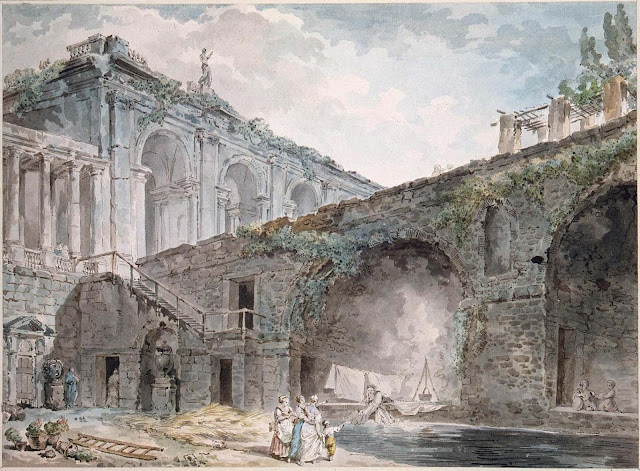 |
| Hendrik Voogd View of Rome through a window 1809 oil on panel Hermitage, Saint Petersburg |
 |
| Hendrik Voogd Landscape with umbrella pines (Borghese Gardens) 1795 oil on canvas Hermitage, Saint Petersburg |
 |
| Hendrik Voogd Landscape with umbrella pines (Borghese Gardens) 1807 oil on canvas Rijksmuseum, Amsterdam |
"The first of the Muses," sayth Fulgentius, "is named Clio, which name she hath out of a Greek word, signifying fame: and by this name there is insinuated unto us the first and greatest motive that stirreth in us a desire of learning: seeing the knowledge of good Arts and Sciences doth extend our fame to the memory of late posterities. The second is Euterpe, that is full of delight; for as we doe first seeke knowledge, so do we afterwards delight in seeking. The third is Melpomene, that is, setling of meditation; for as there followeth upon our first resolution a desire to effect what we have resolved upon, so doth there upon this resolution follow an attentive earnestnesse to obtaine our longing. The fourth is Thalia, that is, apprehension; for it is ever seen that the apprehension, in a mind not altogether uncapable, doth follow upon the earnestnesse of attention. The fifth is Polymnia, that is the remembrance of many things; for it is most of all required after the apprehension that we should perfectly remember the things rightly apprehended. The sixt is Erato, that is, finding something like; for it may justly be exspected, that the Artificer after a well-remembered knowledge, should invent something of his owne, not unlike the things apprehended and remembred by him. The seventh is Terpsichore, that is, delighting in the instruction; for it doth follow upon the invention of new matters, that we should judge of them and discerne them cheerfully. The eighth is Urania, that is, heavenly; for wee doe after this care of judging make choice of such things as are fit to be further wrought upon, leaving the rest; which is the worke of a high and heavenly wit. The ninth is Calliope; that is, of good utterance. The whole connexion is thus linked together. The first degree is, that wee desire knowledge: the second, that we delight in this desire: the third, that we doe eagerly follow the thing wee thus delight in: the fourth, that wee doe apprehend the thing followed: the fifth, that wee remember what we once apprehended: the sixth, that wee doe invent something like unto the remembred apprehensions: the seventh, that wee examine and discerne our inventions: the eighth, that wee choose the best of those things we have judged and discerned: the ninth, that wee doe well expresse the things well chosen."
– Franciscus Junius (1589-1677), from The Painting of the Ancients (1638)
 |
| Jean-Léon Gérôme Slave market in ancient Rome ca. 1884 oil on canvas Hermitage, Saint Petersburg |
 |
| Claude-Joseph Vernet Villa Ludovisi, Rome 1749 oil on canvas Hermitage, Saint Petersburg |
 |
| Hubert Robert Villa Madama, Rome ca. 1760 wash drawing Hermitage, Saint Petersburg |
 |
| Hubert Robert Dome of St Peter's viewed through an arch 1773 oil on canvas Hermitage, Saint Petersburg |
 |
| Louis de Caullery Capriccio view of the Campidoglio, Rome early 17th century oil on panel private collection |
 |
| Antonio Cioci Festival at the Quirinal Palace, Rome 1767 oil on canvas Hermitage, Saint Petersburg |
 |
| Charles Knapton after Gian Paolo Panini Interior of the Pantheon, Rome ca. 1732-36 chiaroscuro woodcut British Museum |
 |
| Gian Paolo Panini Interior of Santa Maria Maggiore, Rome 1754-55 oil on canvas Hermitage, Saint Petersburg |
 |
| Hendrik Frans van Lint Arch of Titus and the Palatine Hill, Rome ca. 1725-50 oil on canvas Hermitage, Saint Petersburg |
 |
| Claude Lorrain View of Trinità de' Monti, Rome 1632 wash drawing Hermitage, Saint Petersburg |
 |
| Joseph Wright of Derby Fireworks display at Castel Sant' Angelo, Rome 1779 oil on canvas Hermitage, Saint Petersburg |